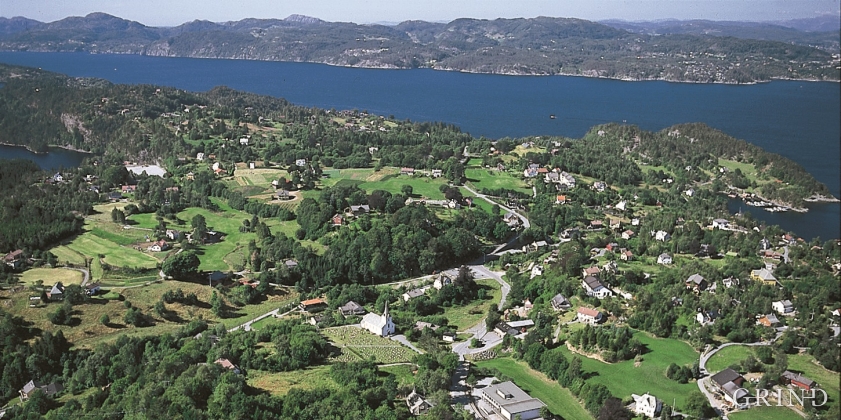Published: 31.07.2015 | Author: Inge Aarseth, Haakon Fossen
Ask mot Herdlefjorden og Holsnøy. (Helge Sunde)
Strawberry-growing on Askøy flourished in the beginning of the last century. When gardener Samson Eik took in the type "Seierherren" from Rosendal in 1909 for growing strawberries on Hop, it appeared that the soil and climate in this area was perfect for the mass production of strawberries.
It is the easily weathered-out mountainside that gives the Askøy-berries their good taste. On parts of the east side of Askøy, the nutrient-rich mica schist has given a very fertile soil - the green fields between Ask and Straumsnes are Askøy's oasis. It was the green Ask where Bergen folk preferred to to build their summer homes on Askøy. Strawberry-growing on the open land there was one of the main businesses on Askøy, and "ask-berries" (or "Ash-berries") have been appreciated and sought after for several generations. Word reached all the way to eastern Norway in the old days. Strawberries from Askøy are still to be had, but today, there are few strawberry farms left that deliver this precious fruit, and the berries are the same kind as are grown everywhere else in the country.
It is easy to distinguish between the depleted gneiss bedrock with pine forest and blueberry bushes growing on it, and the lush mica schist-soils on this part of Askøy. To the south, the boundary goes north of Olavvika Bay, while to the north, this sparkly rocktype takes over steering of the soil near Breivik. In the area between, the strawberries got their growing power and good taste.
Vesle Bergensboge (the "Little Bergen Arc") is what brought the mica schist to Askøy. Between Straumsnes and Ask, this geological phenomenon emerges up from Byfjorden. Then it disappears gradually along the road north to Herdle Fjord. The schists on the east side of Askøy were originally clay. This clay was pressed down into the crust over a long period of time, far down into the depths of the Caledonian Mountain Chain, with temperatures up toward 400–450 °C. At 15–20 kilometres depth, the grains of clay became re-mineralized to mica minerals. Simultaneously, the mineral garnet was formed. When the mountain chain later got eroded down, such that the rock got exposed at the surface, the weathering set in. The minerals became unstable when they came into contact with the atmosphere. Wind and weather didn't let any chance escape to attack the minerals. In this way, the nutrients from the mountainside were released to the soil (see frame).
In the hills on Ask, the mountainside has been weathering away since the Ice Age ended, about 11 500 years ago. This is not especially long in a geological perspective. Because of the poor resistance against weathering in the mica schist, the result nonetheless has been a thick layer of mineral-rich soil. The hard, quartz-rich gneiss bedrock on the island otherwise has been subjected to the same attack from wind and weather over just as long a time. Such rock types require several million years in order to weather out, preferably under much warmer climatic conditions, in order to form a good soil. Therefore, the weathering has not come particularly far in this mountainside.
The area between Straumsnes and Ask is not only endowed with nutrient-rich and easily-broken-down bedrock, it is also better protected against bad weather than many other parts of the municipality. Kolbeinsvarden, Askøy's highest mountain, rises in the southwest. The sea, in addition, is not as rough as it can be on the west side. The geology and the weather conditions have in a way played on the same team, to create the good growing conditions.
Nourishment from stone
Dead plants get broken down by microorganisms which produce carbon dioxide (CO2 ). Dissolved in water, carbon dioxide gives carbonic acid (H2CO3 ). Carbonic acid is a relatively weak acid. But , when it has had a chance to work together with humic acid and liberate hydrogen ions (H+), the effect can be strong: The acid goes loose on minerals that originally were formed at great depths, and transforms them into other minerals that are stable at surface conditions that exist at the earth's surface. This process frees potassium (K) and sometimes also calcium (Ca), elements that are important for making good soil.
A picture from the 1930s; a woman with a typical strawberry basket made of wood. (Loaned:Ivar Tumyr)
- Fossen, H.; Ragnhildstveit, J. 1997. Geologisk kart over Norge, berggrunnskart Bergen – M 1:50.000. Norges geologiske undersøkelse.






